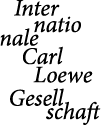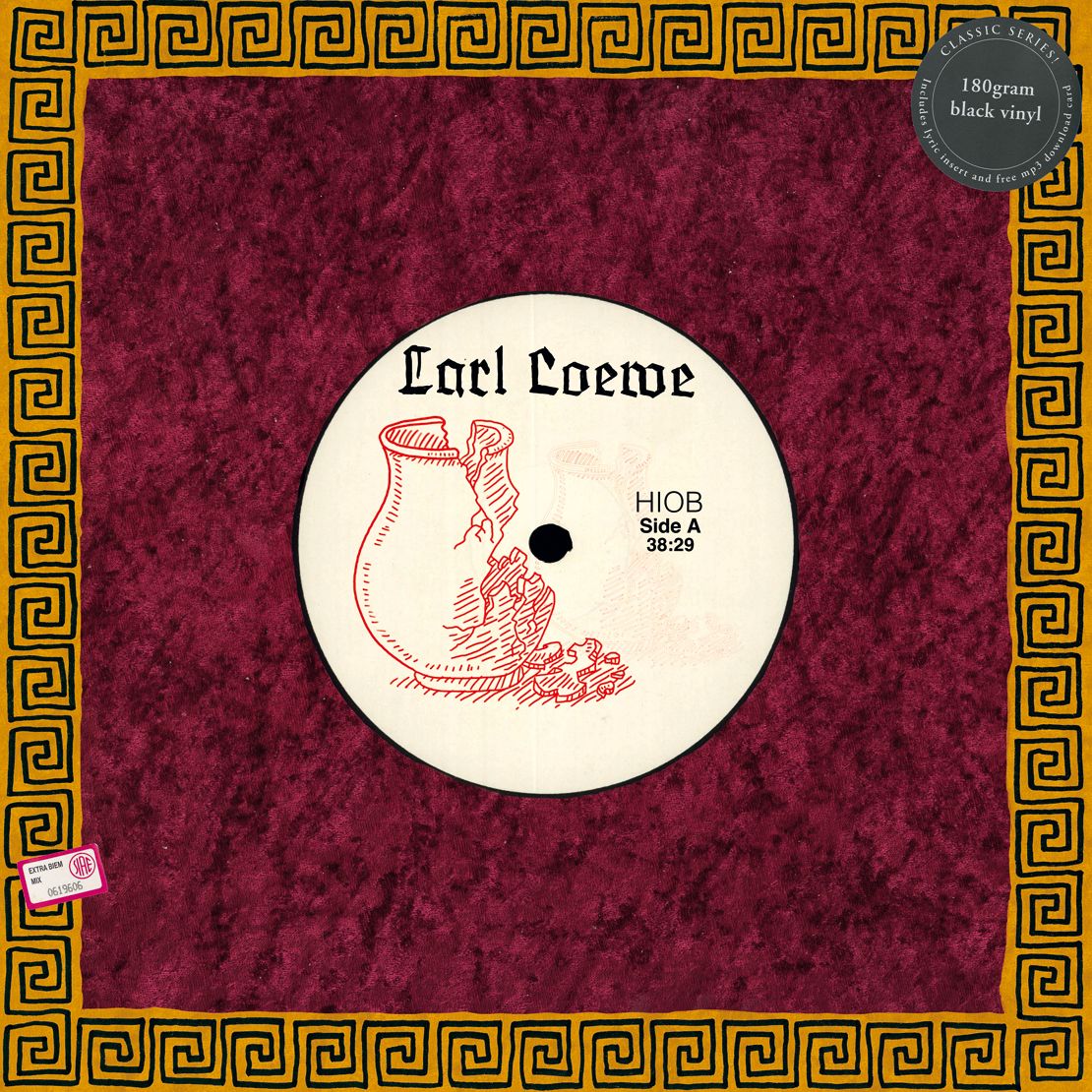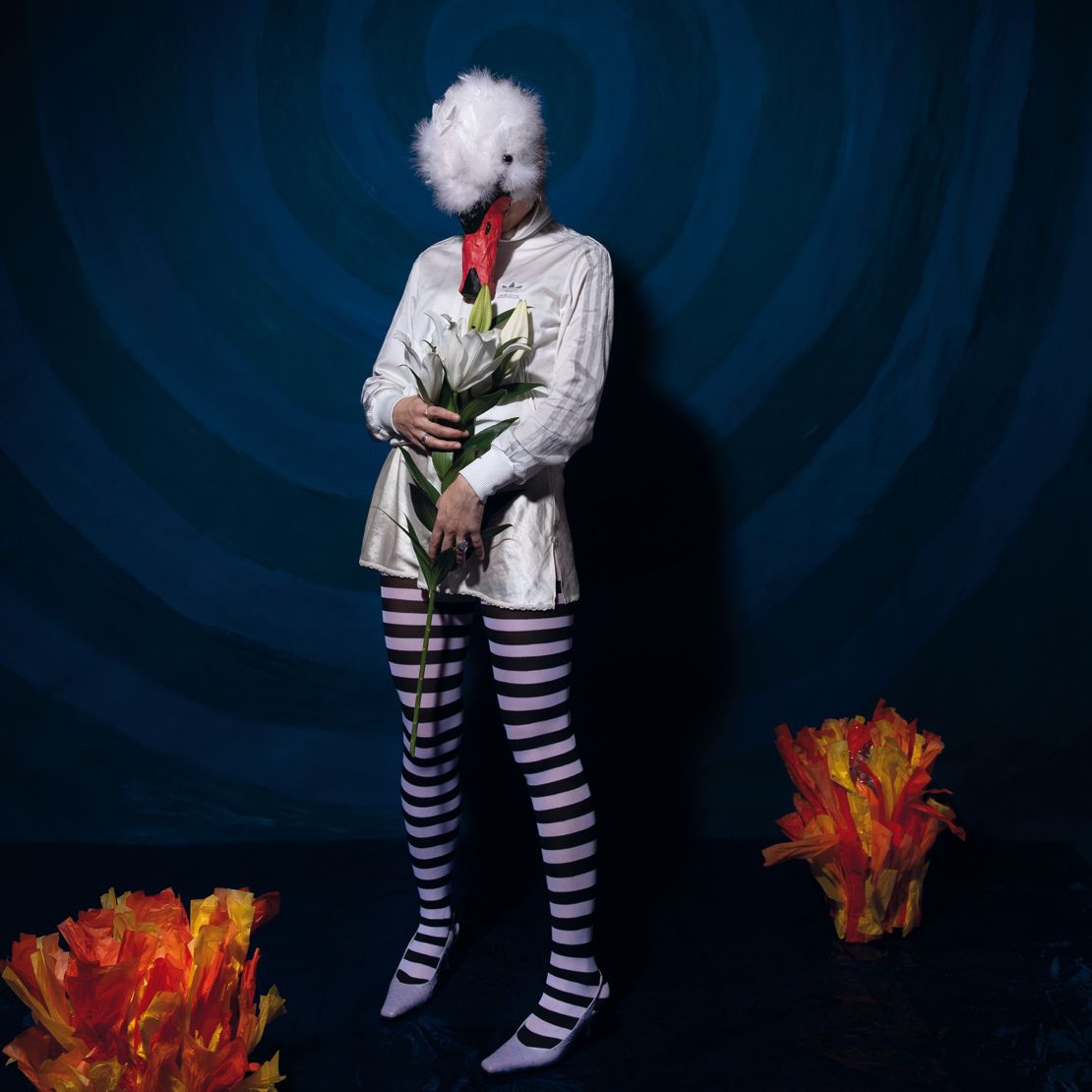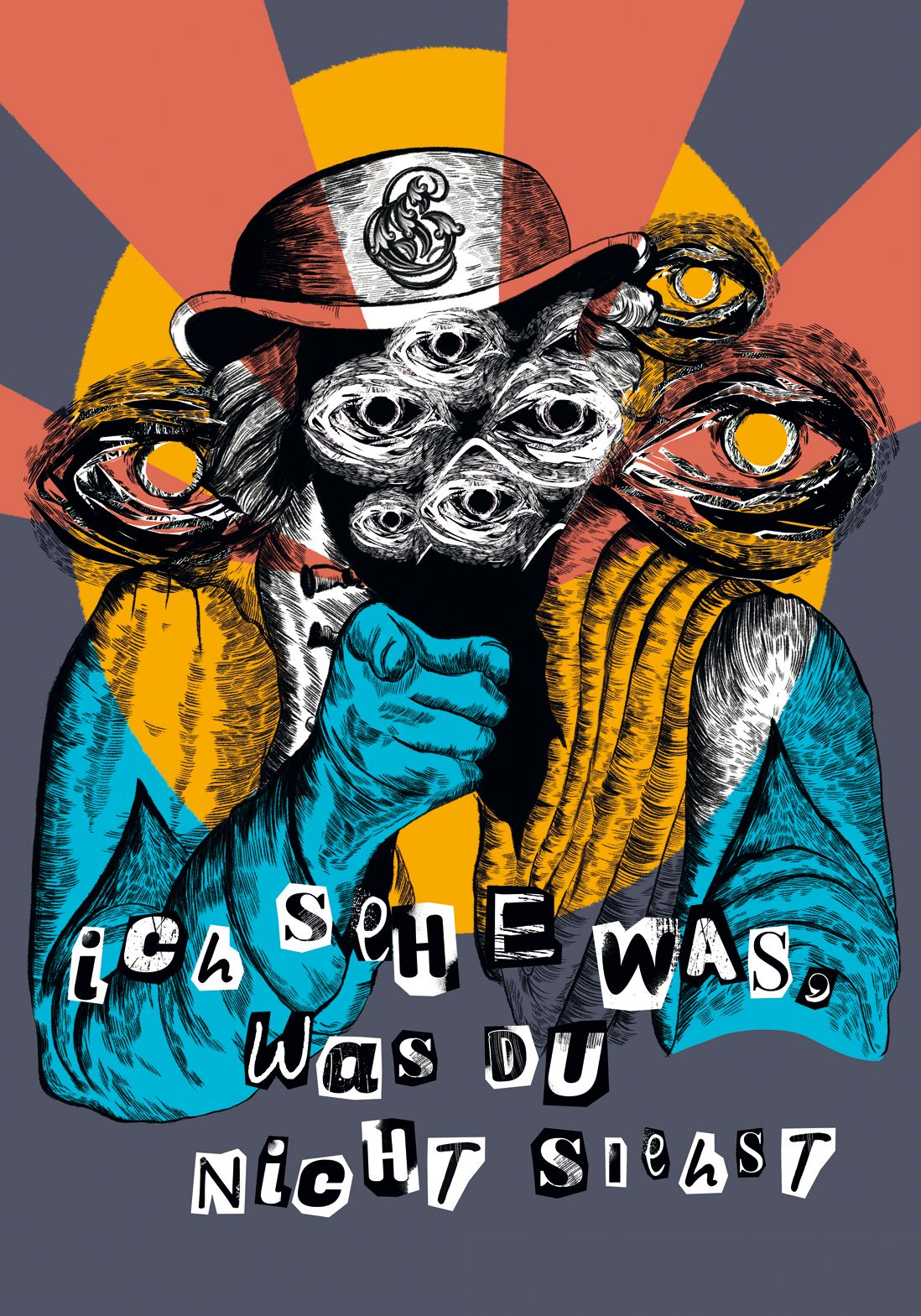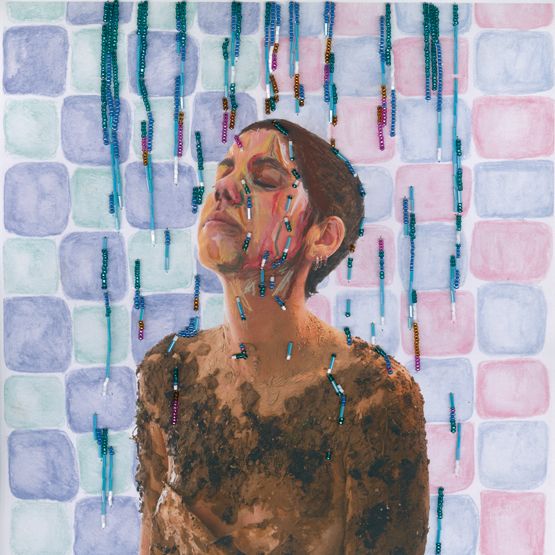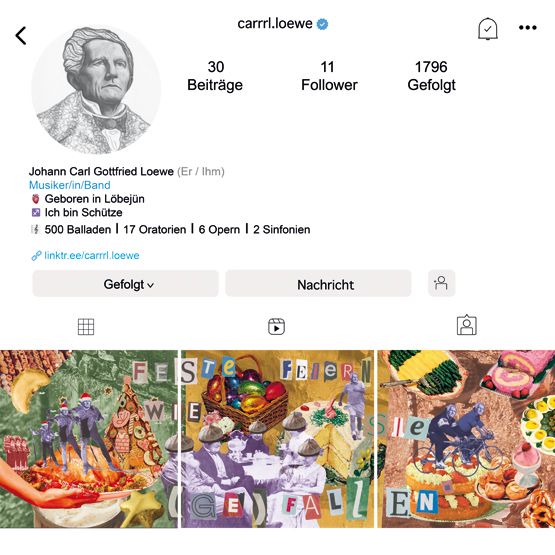Projects
With the Carl Loewe House, Carl Loewe is a significant unique selling point in the city of Löbejün. In a dialogue between guests of the city, the board of the ICLG and those responsible for the city and the local council, the idea arose to use motifs from Carl Loewe's musical work in order to make them present in the cityscape of his hometown. At the same time, empty historical buildings in the old town should be enhanced in the cityscape.
Since Pentecost 2021, motifs from the life and work of Carl Loewe have been visible on large mesh banners.
The project was largely financed by the Saalesparkasse and private donors. We hope for great public interest.
In the run-up to the 9th Carl Loewe Festival in 2024, the project was continued with a new group of students. The new picture collages for Carl Loewe's oratorios were remarkable sound collages that can be accessed on site using a QR code on a smartphone.
For the implementation, we used the experience and artistic and media education skills of Merseburg University of Applied Sciences. In our project, under the leadership of lecturers Thomas Tiltmann, Christian Siegel and Frank Venske, the students initially gained access to Carl Loewe, his life and work from a music and contemporary perspective in the Carl Loewe Museum. The image motifs developed by the students show their intensive engagement with Carl Loewe's musical legacy and provide an answer to how it can be conveyed in our media-cultural world.
The motifs and their interpretation:
Plötzer Tor 1: The bell tower's little daughter
Carl Loewe: "The Bell Tower's Little Daughter" (Text: Friedrich Rückert)
Collage: Lucie Lehmann, Lukas Linßner
The collage deals with the father-daughter relationship and is inspired by the Loewe ballad “The Bell Tower's Little Daughter”.
Carl Loewe's extraordinary relationship with his children and especially with his daughters can be found written down in writings about the “Pomeranian Ballad King”:
“He talked tenderly and charmingly with the young women, he bent down deeper to them, spoke more clearly than with older people, but actually expected just as high things from them as they did, and they were only too happy to believe him (…),” writes Carl Loewe's daughter Julie about her father on the occasion of his 100th birthday in 1896.
The collage was based on a family portrait in which Carl Loewe can be seen with his daughter Julie. This portrait was recreated and re-photographed by the authors in the artistic process. A historical illustration for the ballad “The Bell Tower's Little Daughter” was used and colored as the background for the collage. Both image elements were put together and abstracted into a colorful contemporary interpretation of a father-daughter relationship.
The clock hand of the bell tower points the viewer in the direction of the Carl Loewe Museum, where an in-depth study of Carl Loewe, his family and his works is possible.

Löbejüner Burgstrasse 1
Carl Loewe: “Job”, oratorio, 1848
Collage: Jascha Holst, Moritz Morgenweck
The motif, designed as an album cover, is presented in a deep red. The color scheme is intended to harmonize with Job's story and with the music of Carl Loewe.
A frame with an antique pattern surrounds the cover. This frame, taken from a decades-old cover design for a record with interpretations of Loewe's music, not only gives the design an artistic depth, but also a material connection to Loewe's work.
The focus of the motif is on the record's label: the symbolic representation of a vase. Partially broken and reassembled, it symbolizes Job's suffering in the context of the biblical wager between Satan and God. This visual motif runs as a common thread through the entire project and becomes a symbol of the fragility of human fate and the path to reconstruction. A special detail: the stated running time on the A side of the record, a reference to the book of Job in the Old Testament. In the audio production, the sound of vases breaking and reassembling is woven into a sound collage around the piece “I know” from the Job Oratorio.
Löbejüner Burgstrasse 5
Carl Loewe: "Gutmann und Gutweib" (Text: Johann Wolfgang v. Goethe)
Collage: Katja Heinemann, Anne Hilliger, Vanessa Dobinski
The city view chosen shows the view from the kitchen window of Loewe's birthplace up to the upper market. It allows the viewer to wander towards closed doors and the question of what is happening behind them.
Goethe put one possibility of what happened into words in his ballad “Gutmann und Gutweib”. Carl Loewe staged it musically.
In addition to the historic street, the collage is characterized by Loewe's portrait in the background. With a pensive look he lingers over his birthplace and symbolically accompanies his memory, which he left to Löbejün.
The image-defining portrait was processed using a blueprint, giving it its analogue character.
The collage forms a symbiosis of the composer's significant work and the viewer's inspiration to discover Löbejün from Loewe's perspective.
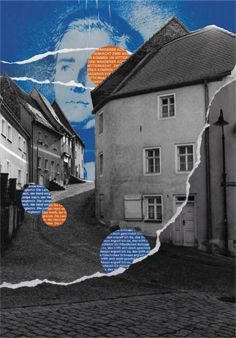
Löbejüner Burgstrasse 6
Carl Loewe: “Jan Hus”, oratorio, 1841
Collage: Stella-Fee Basrawi, Maximilian König, Lisa Krull, Anne Schreiber
The oratorio focuses on Hus's theological views, his struggle against church authority, and his eventual condemnation and execution. To represent this story in a surrealist photograph, we chose the swan for aesthetic reasons as the embodiment of the Reformation thought that took shape 100 years later in Martin Luther. The Madonna lily symbolizes the pure and innocent character of Jan Hus. The mood of the oratorio is reflected in an enchanted, spiral-shaped background. The pyre on which Hus is burned, which is stylized here by flames, expresses even more drama. Through sound design we acoustically created a scenery in medieval Bohemia. Using simple stylistic devices from folk music, a section of the choir singing from Carl Loewe's “Jan Hus” was reinterpreted and recorded. Some of the audio recordings were made in the town church of Löbejün, the place where Carl Loewe's musical work originated.
Löbejüner Burgstraße 6 - right
Carl Loewe: “The Clock” (Text: Gabriel Seidel)
Collage: Thomas Tiltmann, Christian Siegel
What characterizes the collage is the portrait of Carl Loewe, whose gaze looks into the vastness of life. The eyes are framed by hearts held by figures. She
symbolize Carl Loewe's love for music, the church and his hometown Löbejün.
“The clock” above the left eye establishes the reference to the ballad. The notes used show an excerpt from this ballad and indicate the composer's work.
Numerous clockwork gears can be seen on the right shoulder. They could be part of the clockwork of the church clock of the city church of St. Petri.
Loewe's love of his homeland and his connection to the city of Löbejün are illustrated by another motif on the chest. It shows the tower of St. Petri, Loewe's baptismal church.
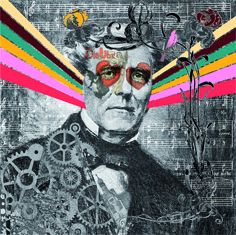
Rathausstrasse 32
Carl Loewe: “Gutenberg”, oratorio, 1836
Collage: Marieke Anders, Farrah Fischer, Marie Gradlewski, William Jagemann
The motif is linked to the Gutenberg Oratorio in terms of design and theme and shows a portrait of Gutenberg. He can be recognized by the Gutenberg “G” on his hat.
At the center of the depiction are Gutenberg's eyes, which serve as a central stylistic device. They direct the gaze directly at the viewer and ensure participation and provocation.
His raised index finger, which is directed at the viewer in a warning and powerful manner, is intended to draw attention to the displacement of the printing press, invented by Gutenberg, by the constantly evolving digital media. We would like to give this problem a face, a face that draws attention to this change and counteracts the forgetting of printing.
The writing, designed as a threatening letter, refers to the art of printing, as well as the letter of defiance, which is part of Gutenberg's story in the oratorio.
“I see something you don’t see,” a saying that we all probably know. Effective, provocative and questioning.
Karl-Heyer-Straße 12 (left)
Carl Loewe: “The Raising of Lazarus”, oratorio, 1863
Collage: Emilia Koch, Pauline Stöcker,
Andrea Aviles Torres
In “The Raising of Lazarus” Loewe has set the biblical story to music. It ends with Lazarus coming out of his grave cave, in which he had already lain dead for four days. Dirt, stench and confusion accompany the person. But what happens after such an experience?
The cleansing and washing of Lazarus became the main theme. A person, still carrying death, experiences the cleansing of the body and soul with water. In the accompanying sound piece, the process inside the human being can be accompanied. From awakening, initial disorientation and confused memories to finding peace.
Karl-Heyer-Straße 12 (right)
Carl Loewe: “The Festival Times”, oratorio, 1825-1836
Collage: Emely Beret, Tom-Leon Heinschker, Jessy Mühlbach, Julia Zerche
Carl Loewe now has Instagram and uses it to welcome guests and residents to the historic Schützenhaus!
Loewe can be seen in the banner at the top left, with a short description below with all the important information. The number of posts at 30, followers at 11 and followed at 1796 is a reference to his birthday. Typical dishes were selected for the selected holidays, true to the motto “Celebrate festivals as they please”.


